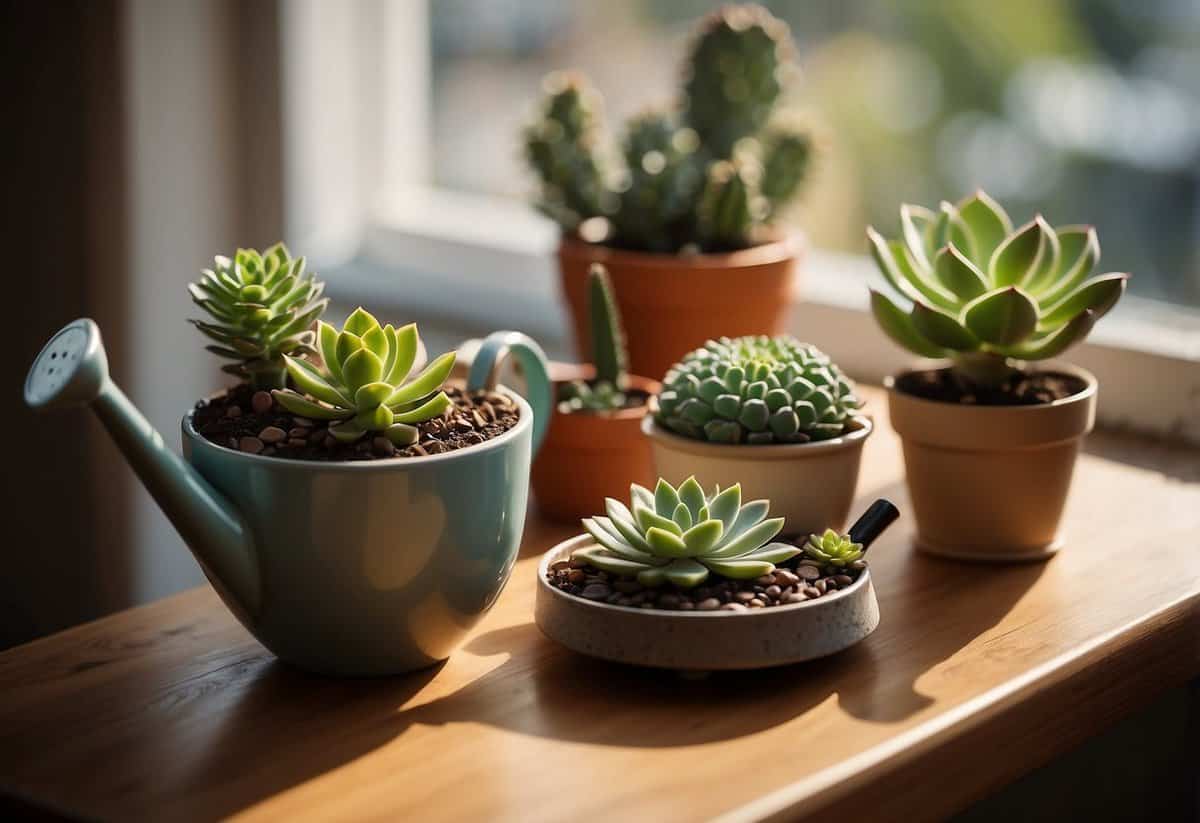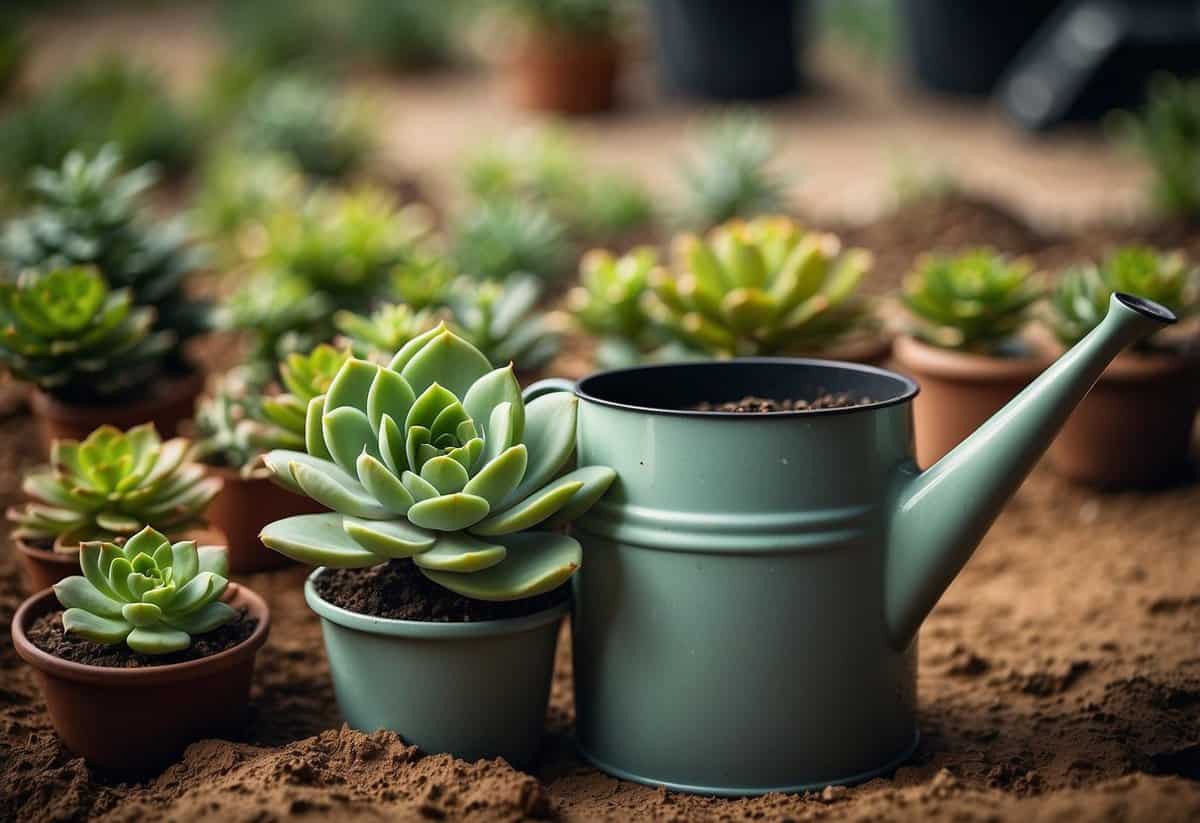Succulent Care Tips: Easy Ways to Keep Your Plants Thriving
Succulents are a fantastic option if you’re looking for low-maintenance and attractive plants to add to your home. With their thick, fleshy leaves, these plants are perfect for those who might not have a green thumb but still want to enjoy the beauty of indoor plants. This article will provide you with easy and practical tips to care for your succulents, ensuring they stay healthy and vibrant.

Caring for succulents doesn’t have to be complicated or time-consuming. Whether you’re new to gardening or just looking to improve your plant care routine, you’ll find helpful advice here. By following these tips, you can create an environment where your succulents will thrive and add a touch of nature to your space.
1) Choose the Right Soil

Choosing the right soil is crucial for your succulents’ health. Succulents need well-draining soil to prevent root rot.
A great option is a mix that includes sand and perlite. This mix helps water flow easily. You can also find specialized succulent soil mixes at garden stores.
These pre-made mixes are designed to provide the right balance for succulents. Remember, using the correct soil can make a big difference in your succulent’s growth and overall health.
2) Watering Schedule

For succulents, it’s essential to let the soil dry out completely between waterings. This is known as the “soak and dry” method. Water deeply until excess drains out.
During the growing season, water about once a week. In the dormant season, water less frequently.
Always check the soil moisture. If it’s still damp, wait a few more days before watering again.
3) Proper Drainage

Proper drainage is essential for healthy succulents. Without it, plants can develop root rot and other issues.
Use a container with drainage holes. This lets excess water escape, preventing soggy soil.
Combine potting soil with sand or perlite. This helps the soil drain quickly, keeping roots dry.
For more details, check out Succulents & Drainage.
4) Sunlight Needs

Succulents love sunlight but need the right amount to thrive. Most do well with 12 to 18 hours of light per day.
When moving succulents from indoors to outdoors, do it gradually. Start by placing them in a bright location without direct sunlight for about 8-10 days.
Using a grow light can help ensure your succulents get even light. Adjust brightness and use a timer to match the seasons.
Check out more on how much light succulents need.
5) Temperature Preferences

Succulents thrive in temperatures between 60°F to 80°F (15°C to 27°C) during the day. At night, they prefer it cooler, between 50°F to 70°F (10°C to 20°C).
Keep an eye on your plants as temps above 90°F (32°C) can cause heat stress. Watch for signs like wilting leaves or yellowing.
Cold-hardy succulents can handle lower temperatures, making them a good choice if you live in a cooler climate.
6) Fertilizing Routine

Fertilizing your succulents is key to keeping them healthy and growing. The best time to fertilize is in early to mid-spring. This is when your succulents wake up from their winter rest and start growing again.
Avoid fertilizing in fall and winter, as new growth can be damaged by the cold.
Choosing the right fertilizer matters too. Use a balanced, water-soluble fertilizer. Banana peels can also be a good source of potassium for your succulents. For more details, check out this guide on how and when to fertilize succulent plants.
7) Pruning Techniques

Pruning your succulents helps them stay healthy and look their best. Start by using clean, sharp scissors. Make sure to disinfect your tools with rubbing alcohol to prevent disease.
Trim off any dead or dying leaves. This keeps the plant from wasting energy. Remove spines at the end of agave leaves if necessary but be careful—pruning spines can cause browning.
After pruning, let the cuts dry and “scab” over before watering. This helps prevent rotting. Healthy tips can be propagated to grow new plants.
8) Pest Control

You will likely run into pests on your succulents at some point. It’s important to inspect your plants regularly, looking for tiny bugs or damage.
For small infestations, mix a few drops of dish soap in 1-2 cups of water and spray the affected areas. Neem oil also works well; dilute one tablespoon in eight cups of water.
Keep your succulents in well-draining soil and avoid overwatering to prevent root rot and diseases. Make sure your plants are in a well-ventilated area to keep pests away. Regular checks and proper care will help keep your succulents healthy and pest-free.
9) Repotting Succulents

Repotting succulents helps them thrive. First, pick a new pot that’s 20% bigger than the current one for extra room.
Gently remove the succulent from its old pot. If it’s prickly, wrap the stem with a cloth. Shake off any old soil from the roots.
Place the succulent in the new pot and backfill it with fresh soil. Make sure the soil packs firmly around the roots. Water the plant thoroughly and let the soil dry completely before watering again to avoid overwatering. For more details, check out this guide on how to repot succulents.
10) Avoid Overwatering

Watering your succulents too much is a common mistake. These plants are used to dry conditions and don’t need frequent watering.
Check the soil before you water. It should be completely dry. Use a well-draining soil mix and pots with drainage holes to help prevent water from sitting at the bottom.
Yellowing leaves and a mushy stem can mean your succulent is overwatered. Learn more about care at Garden Tabs.
Understanding Succulents

Succulents are unique plants that come in many types and varieties. They are known for their ability to store water in their leaves, stems, and roots. This makes them easy to care for and ideal for both indoor and outdoor gardens.
Types of Succulents
There are many types of succulents, each with its own features. Cacti are among the most well-known, characterized by their thick, spiny bodies. Aloe plants are also popular, featuring fleshy leaves often used for medicinal purposes. Echeveria is another common type, recognizable by its rosette shape and vibrant colors. Sedum plants have small, fleshy leaves that can form dense mats, perfect for ground cover.
Another type worth mentioning is Kalanchoe, known for its bell-shaped flowers. Crassula genus includes the famous jade plant, which is easy to grow and maintain. Each type has its own care needs, but they all generally require well-draining soil and ample sunlight.
Popular Succulent Varieties
Among the many varieties, the Jade Plant (Crassula ovata) is a favorite for its thick, glossy leaves. It’s often seen as a symbol of good luck and is easy to care for. Aloe Vera is another popular variety, known for its medicinal properties and soothing gel. Burro’s Tail (Sedum morganianum) is appreciated for its trailing growth and unique appearance.
Echeveria ‘Lola’ is admired for its beautiful, rose-like shape and pastel colors. Panda Plant (Kalanchoe tomentosa) attracts attention with its fuzzy leaves edged in brown. Then there’s the Zebra Plant (Haworthia fasciata), which stands out with its striking white stripes. Each of these varieties has unique features that make them popular among succulent enthusiasts.
Watering Succulents

Watering succulents properly ensures their healthy growth. Understanding when and how to water, along with recognizing signs of overwatering, is crucial.
Watering Schedule
For succulents, it’s important to let the soil dry out between waterings. The ideal method is the “soak and dry” approach, where you thoroughly soak the soil and then let it dry completely before watering again. Indoor succulents typically need watering every 2-3 weeks, while outdoor ones may need slightly more frequent watering, especially in hot climates.
Use rainwater or distilled water when possible, as tap water can leave mineral deposits on the leaves. Always check the soil moisture a week after watering; if it’s still damp, wait longer before watering again.
Signs of Overwatering
Overwatering is one of the most common problems when caring for succulents. Signs include yellow or translucent leaves and a soggy stem. If you notice these symptoms, reduce the watering frequency and check for root rot.
Another sign is mold on the soil surface, indicating excess moisture. Ensure your pot has proper drainage and empty any collected water from the saucer below. Let the soil dry completely between waterings to prevent these issues and keep your succulents healthy.







